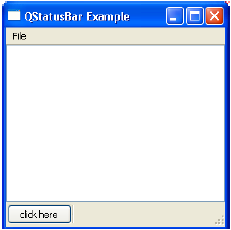
- PyQt Tutorial
- PyQt - Home
- PyQt - Introduction
- PyQt - Hello World
- PyQt - Major Classes
- PyQt - Using Qt Designer
- PyQt - Signals and Slots
- PyQt - Layout Management
- PyQt - Basic Widgets
- PyQt - QDialog Class
- PyQt - QMessageBox
- PyQt - Multiple Document Interface
- PyQt - Drag and Drop
- PyQt - Database Handling
- PyQt - Drawing API
- PyQt - BrushStyle Constants
- PyQt - QClipboard
- PyQt - QPixmap Class
- PyQt Useful Resources
- PyQt - Quick Guide
- PyQt - Useful Resources
- PyQt - Discussion
PyQt - QStatusBar Widget
QMainWindow object reserves a horizontal bar at the bottom as the status bar. It is used to display either permanent or contextual status information.
There are three types of status indicators −
Temporary − Briefly occupies most of the status bar. For example, used to explain tool tip texts or menu entries.
Normal − Occupies part of the status bar and may be hidden by temporary messages. For example, used to display the page and line number in a word processor.
Permanent − It is never hidden. Used for important mode indications. For example, some applications put a Caps Lock indicator in the status bar.
Status bar of QMainWindow is retrieved by statusBar() function. setStatusBar() function activates it.
self.statusBar = QStatusBar() self.setStatusBar(self.statusBar)
Methods of QStatusBar Class
| Sr.No. | Methods & Description |
|---|---|
| 1 |
addWidget() Adds the given widget object in the status bar |
| 2 |
addPermanentWidget() Adds the given widget object in the status bar permanently |
| 3 |
showMessage() Displays a temporary message in the status bar for a specified time interval |
| 4 |
clearMessage() Removes any temporary message being shown |
| 5 |
removeWidget() Removes specified widget from the status bar |
Example
In the following example, a top level QMainWindow has a menu bar and a QTextEdit object as its central widget.
Window’s status bar is activated as explained above.
Menu’s triggered signal is passed to processtrigger() slot function. If ‘show’ action is triggered, it displays a temporary message in the status bar as −
if (q.text() == "show"): self.statusBar.showMessage(q.text()+" is clicked",2000)
The message will be erased after 2000 milliseconds (2 sec). If ‘add’ action is triggered, a button widget is added.
if q.text() == "add": self.statusBar.addWidget(self.b)
Remove action will remove the button from the status bar.
if q.text() == "remove": self.statusBar.removeWidget(self.b) self.statusBar.show()
The complete code is as follows −
import sys
from PyQt4.QtCore import *
from PyQt4.QtGui import *
class statusdemo(QMainWindow):
def __init__(self, parent = None):
super(statusdemo, self).__init__(parent)
bar = self.menuBar()
file = bar.addMenu("File")
file.addAction("show")
file.addAction("add")
file.addAction("remove")
file.triggered[QAction].connect(self.processtrigger)
self.setCentralWidget(QTextEdit())
self.statusBar = QStatusBar()
self.b = QPushButton("click here")
self.setWindowTitle("QStatusBar Example")
self.setStatusBar(self.statusBar)
def processtrigger(self,q):
if (q.text() == "show"):
self.statusBar.showMessage(q.text()+" is clicked",2000)
if q.text() == "add":
self.statusBar.addWidget(self.b)
if q.text() == "remove":
self.statusBar.removeWidget(self.b)
self.statusBar.show()
def main():
app = QApplication(sys.argv)
ex = statusdemo()
ex.show()
sys.exit(app.exec_())
if __name__ == '__main__':
main()
The above code produces the following output −
